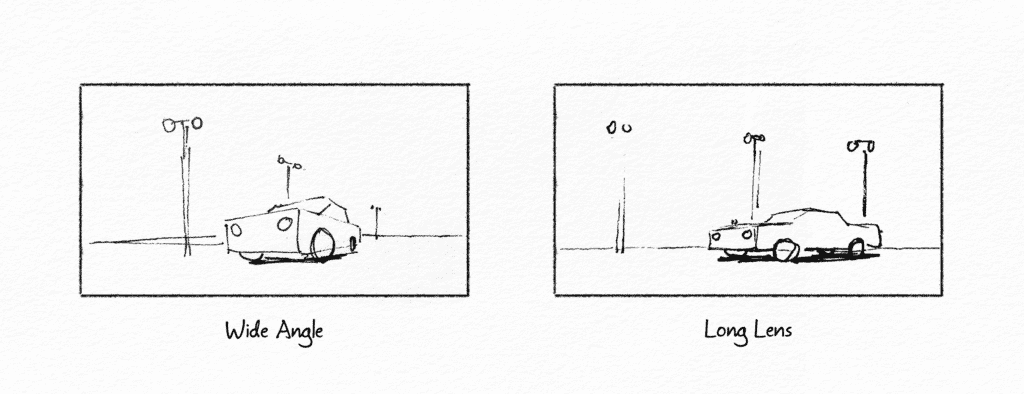PERSPECTIVE drawing for STORYBOARD Artists
Vanishing points, horizon line, perspective grids, 1-point, 2-point… – Perspective can sound really complicated, but when it comes to storyboard drawing, we only need to know some basic concepts.
Depth
The most fundamental concept for perspective drawing, is something we even heard as kids: “if something is further away, it looks smaller”. And yeah, if you go out on the street and look at the buildings or cars, you’ll notice that the closer they are, the bigger they look, and the further away they are, the smaller they look.
There are many mathematical rules and guides for drawing this effect, like 1-point, 2-point, 3-point, 5 point perspective… But for storyboards you don’t need that, all you need to remember is that things in the distance look smaller than the things in front of you.
Horizon Line
If you’ve ever drawn 1-point, 2-point or 3-point perspective, you’ve heard of horizon line. That’s the line where you put your vanishing points. It’s the line that separates sky from the ground.
In essence, horizon line represents our “eye level”, everything that’s drawn on a horizon line, is on the same height as our eyes, or when it comes to storyboards, the same height as our camera.
You can see why this concept is important for storyboards. With just a few lines, by drawing a face above horizon line, we’re communicating to our filmmakers that the camera needs to be below the level of our actor’s head.

Notice how, wherever we put the camera, the horizon line stays in the middle of the frame. That is, if the camera is looking straight ahead. If we tilt the camera to look up or down, then the position of the horizon line changes.
Camera Tilt
When it comes to horizon line, you probably heard terms like “high horizon”, “low horizon”, “mid horizon” and so on. That basically means how high on the panel is the horizon line. And that is closely related with the camera tilt.
As we already mentioned, horizon line is the “eye level” or the “camera level” in our case. When we tilt the camera down, we’re looking at the stuff that’s below the camera and the horizon line will appear higher on the image. When we tilt camera up, we’re looking at the stuff that’s above the camera level, so the horizon line will be towards the bottom of the image.

Notice how on the first drawing, horizon line is at the eye level and the camera is tilted down a bit. On the middle image, horizon line is at the waist level. And in the third image, horizon line is at the knee/feet level and camera is looking up.
This is a really simple way to convey camera angle with perspective drawing in a storyboard.
One of the common tools filmmakers use to make the sense of unease is the “Dutch angle”, which is achieved by rolling the camera to a certain degree. And when it comes to drawing that effect, we just need to rotate the whole drawing for a bit, and in that case, the horizon line is going to be tilted.
Focal length
One of the essential parts of the camera is the lens. And you’ve probably heard of different types of lenses: wide angle lens, telephoto lens…
If you look at the images taken with these different lenses you can see that they differ a lot. Wide angle usually looks more dynamic and distorted, while telephoto looks more distant and flat.

Conveying these lenses in a drawing can be pretty tricky, and requires a good knowledge of perspective. But in a nutshell, if you draw a 2-point perspective image, and you bring the vanishing points closer together you’ll achieve the wide lens effect. And if you move them further away you’ll get the long lens effect.
I’ll leave you a link to an amazing video on this topic, by the moderndayjames
Conclusion
Camera placement and camera lenses can be used very effectively to convey emotion and tell a story. Putting the camera below the actor, makes that character look more intimidating. Putting the camera above the actor, and distancing it, makes the character look small and insignificant.
As storyboard artists, we need to be able to convey those ideas, and the way we can do that is by understanding some basic principles of perspective drawing.
